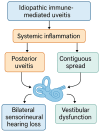Correlation Between Idiopathic Immune-Mediated Uveitis and Audiovestibular Involvement: A Cross-Sectional Study
- PMID: 40429512
- PMCID: PMC12112101
- DOI: 10.3390/jcm14103517
Correlation Between Idiopathic Immune-Mediated Uveitis and Audiovestibular Involvement: A Cross-Sectional Study
Abstract
Background/Objectives: Idiopathic immune-mediated uveitis (IIMU) is an intraocular inflammatory condition affecting the uveal tract and adjacent ocular structures, potentially leading to systemic involvement. Audiovestibular symptoms, such as sensorineural hearing loss (SNHL) and balance disturbances, are often underdiagnosed in these patients. The potential correlation between IIMU and audiovestibular dysfunction remains insufficiently studied. This study aimed to estimate the prevalence and describe the clinical characteristics of audiovestibular manifestations in patients with IIMU. Methods: We conducted a cross-sectional observational study of 34 patients with a confirmed diagnosis of IIMU at a tertiary academic center. All participants underwent a standardized neurootological assessment, including pure-tone audiometry, video head impulse testing (vHIT), and cervical vestibular-evoked myogenic potentials (cVEMP). Demographic and clinical data were also collected. Results: Audiovestibular dysfunction was identified in 41.18% of patients, with bilateral SNHL (B-SNHL) being the most common finding. Patients with B-SNHL had a significantly later age of uveitis onset (52.3 ± 14.4 vs. 35.9 ± 13.9 years, p = 0.003) and a higher incidence of ocular complications (83.3% vs. 59.1%, p = 0.252). Furthermore, worsening ophthalmologic activity was observed in 25% of patients with B-SNHL, compared to 0% in those without B-SNHL (p = 0.037). Vestibular dysfunction was also associated with delayed onset of uveitis (51.0 ± 17.4 vs. 36.0 ± 12.2 years, p = 0.006) and a non-significantly higher complication rate (76.9% vs. 61.9%, p = 0.465). Conclusions: Audiovestibular dysfunction is a frequent finding in patients with IIMU and is associated with delayed uveitis onset and greater ocular morbidity. These results support the inclusion of systematic audiovestibular screening in clinical evaluations of IIMU patients and suggest that earlier detection may inform prognosis and guide multidisciplinary management strategies.
Keywords: idiopathic immune-mediated uveitis; intraocular inflammation; multidisciplinary management; sensorineural hearing loss; vestibular disorders; vestibular tests.
Conflict of interest statement
The authors declare no conflicts of interest.
Figures
Similar articles
-
Prevalence of abnormal vestibular responses in children with sensorineural hearing loss.Eur Arch Otorhinolaryngol. 2022 Oct;279(10):4695-4707. doi: 10.1007/s00405-021-07241-2. Epub 2022 Feb 14. Eur Arch Otorhinolaryngol. 2022. PMID: 35156132
-
Diagnosing Vestibular Hypofunction in Children with Sensorineural Hearing Loss: Using the Video Head Impulse Test or the Caloric Test First Not the Cervical Vestibular Evoked Myogenic Potential.J Clin Med. 2025 Apr 15;14(8):2721. doi: 10.3390/jcm14082721. J Clin Med. 2025. PMID: 40283554 Free PMC article.
-
Prognosis of vestibular dysfunction in idiopathic sudden sensorineural hearing loss with vertigo: a prospective cohort study.J Neurol. 2023 Nov;270(11):5516-5526. doi: 10.1007/s00415-023-11894-w. Epub 2023 Jul 30. J Neurol. 2023. PMID: 37517037
-
The audiovestibular manifestations as early symptoms of multiple sclerosis: a scoping review of the literature.Ir J Med Sci. 2022 Feb;191(1):391-400. doi: 10.1007/s11845-021-02508-3. Epub 2021 Feb 5. Ir J Med Sci. 2022. PMID: 33544333
-
Vestibular Assessment in Infants with Congenital or Early Onset Sensorineural Hearing Loss: Is Neonatal Vestibular Screening Required? A Scoping Review.Audiol Res. 2025 Feb 27;15(2):23. doi: 10.3390/audiolres15020023. Audiol Res. 2025. PMID: 40126271 Free PMC article. Review.
References
-
- Smith J.R., Thorne J.E., Flaxel C.J., Jain N., Kim S.J., Maguire M.G., Patel S., Weng C.Y., Yeh S., Kim L.A. Treatment of Noninfectious Uveitic Macular Edema with Periocular and Intraocular Corticosteroid Therapies: A Report by the American Academy of Ophthalmology. Ophthalmology. 2024;131:1107–1120. doi: 10.1016/j.ophtha.2024.02.019. - DOI - PubMed
LinkOut - more resources
Full Text Sources


